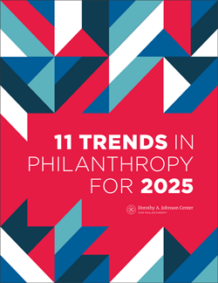More Foundations Opt for Planned Lifespans and Spend-Down Strategies


 This article was first published in our 11 Trends in Philanthropy for 2025 report. Explore the full report here.
This article was first published in our 11 Trends in Philanthropy for 2025 report. Explore the full report here.
Want the latest trends, research, and more delivered right to your inbox? Subscribe to the Johnson Center email newsletter.
In September 2024, 94-year-old Warren Buffett, who has long advocated the “giving while living” approach, announced that his three children will have just 10 years after his death to allocate what remains of his $143.1 billion fortune via a charitable trust (Koenig, 2024). It’s a bold approach that seems to be gaining interest: setting an end date for a charitable entity and making more, and often significantly larger grants, at an accelerated pace to meet that deadline.
Within the philanthropic ecosystem, a growing number of foundations, trusts, and charitable entities are adopting this spend-down strategy — also referred to as “spend out,” “sunsetting,” or even “spend up” or “sunrise.” Whatever the preferred terminology, this language reflects the fact that endowed foundations may very well need to distribute their principle faster than the rate of return on their investments, and within a designated amount of time; directives mostly range from five to 20 years.
Some of the organizations that are now in spend-down mode were first established as perpetual entities and have now shifted course. Others, known as limited-life entities, began their organizational lives with a clear end date in mind. At times, these end dates are set for a certain period after the death of a donor or trustee(s): a prominent example of this latter form is The Gates Foundation, which will cease to exist 20 years after the last of its founders passes away (Suzman, 2024, para. 7).
Gathering concrete data on foundations’ decisions to sunset, or on the number of organizations in active spend out, is elusive. More than a decade ago, estimates were that 9% to 12% of foundations were in spend-down mode, with about a quarter considering the idea (Ostrower, 2009; Foundation Center, 2009). New research by the National Center on Family Philanthropy (2025) found that in the past five years, the number of family foundations in active spend down rose from 9% to 13% and that more than 28% were considering it.
Since the traditional U.S. foundation model is usually structured to exist in perpetuity (i.e., with no end date), announcements of foundations’ planned closures make news. One of the most notable closures was The Atlantic Philanthropies, established in 1982 by the late entrepreneur Chuck Feeney, which gave out more than $8 billion in grants during its 38-year lifetime to a wide variety of causes around the globe — from advancing the peace process in Northern Ireland, to modernizing Vietnam’s health systems, and even catalyzing the U.S. Affordable Care Act. “I see little reason to delay giving when so much good can be achieved through supporting worthwhile causes today,” said Feeney (Waleson, 2017, p. 39). Feeney’s other famous quote: “It’s a lot more fun to give while you’re alive than to give while you’re dead” (The Atlantic Philanthropies, 2024, para. 3).
Today, interest in spending down seems to be on the rise. While smaller foundation closures might not get major attention, more foundations are electing to shift to a sunset strategy — and some are promoting their decision to maximize giving in the present, likely hoping other grantmaking entities will follow suit. Some notable closures in the last few years include The Whitman Institute in 2022, which launched the Trust-Based Philanthropy Project, the WEM Foundation in 2023, and the Chorus Foundation in 2023. In recent years, others have announced being in active spend-down mode: the Levitt, Compton, Stupski, and Ivey Foundations have all made public statements to give away their full endowments.
Counter to foundations’ standard pace of giving, often matching the federally-mandated annual minimum distribution requirement of 5% of assets for charitable purposes, organizations that transition to a spend-down strategy may need to double, or even triple grantmaking to take the endowment down to zero. As the Ivey Foundation (2022) board wrote in their open letter announcing their plans to wind down, “Foundations need not continue in perpetuity for perpetuity’s sake. There is a strong argument that their philanthropic resources can, and in some cases should, be fully utilized for the most critical issues we face today” (para. 6).
And the numbers are compelling. Take the example of the Mortimer & Mimi Levitt Foundation, which supports free live music in underused public spaces. While the foundation gave away $20 million during the 20-year period of 2002–2021, its recent adoption of a spend-down strategy will have major impacts on its giving. From 2022 to the foundation’s closure date in 2041, it will spend $150 million (Levitt Foundation, 2023). Even more massive: The Ralph C. Wilson Jr., Foundation — which supports a wide range of causes in Southeast Michigan and Western New York and was established as a limited-life entity in 2015 — will spend out $1.2 billion by 2035.
Whether the decision to sunset is made at the outset of a foundation’s creation or by the board of trustees during the foundation’s lifetime, key motivations seem to be the ability to make a larger impact in the present; the urgency of societal challenges such as the climate crisis, economic inequality, and forced migration; and in some cases, poor economic circumstances such as the 2007–2009 Great Recession (Hengevoss & von Schnurbein, 2024; Markham & Ditkoff, 2013). Foundation leaders reported that a fixed time frame can also sharpen discussions, decision-making, and strategic focus (Mansson, 2020).
Spending down can also be part of a donor’s philosophical stance of avoiding dynastic wealth or the belief that those who earned wealth should also be the ones to distribute it back to the community and that other donors will continue to give in the future (O’Donnell & Chen, 2023). Other donors prioritize giving during their lifetime to avoid a perpetually endowed foundation drifting away from their intent or becoming overly bureaucratic (Markham & Ditkoff, 2013). While it has not been mentioned as often, conversations at conferences and donor gatherings note another force driving this change: younger generations may have waning interest in running a family’s foundation well into the future.
Little research beyond the occasional collection of case studies or a foundation’s own reports have studied this phenomenon. A 2019 report by the Johnson Center investigated the impact of foundations’ exits on nonprofits (Behrens & Gordillo). Recently, two researchers at the Center for Philanthropy Studies at the University of Basel, Switzerland, identified different strategies for foundations to sunset smoothly and successfully: either taking a resource-based approach based on the assets available, or a needs assessment view, being responsive to the needs of beneficiaries and offering as much support as possible (Hengevoss & von Schnurbein, 2024).
One critique of foundations closing is when it happens suddenly and without the ability for grantees to give input or plan for the sustainability of programs (Behrens & Gordillo, 2019; Johnston, 2009). At the same time, the need to move money out the door can also be transformational (Honig et al., 2021). According to a 2024 news report, when the WEM Foundation closed, many organizations received the largest gifts in their organization’s history, enabling them to purchase or renovate buildings, expand programs, and plan for the future (Smith). Investing in future leaders, building organizational capacity, pioneering new research, and changing policies are other enduring outcomes that philanthropic advisors say magnify influence (Markham & Ditkoff, 2013).
In short, spending down is a strategy that may or may not be right for each charitable entity, but it’s a question that more foundation boards might start asking themselves and from which others across the sector can learn. Spending down allows a funder to view the entirety of a foundation’s endowment as a “holistic institutional strategy” capable of making big commitments (Henderson & Ebrahimi, 2024, para. 11). And when those grants respond to specific urgent needs that reduce grantees’ overall reliance on philanthropy, the impact can be even greater.
Even in the philanthropic sector, organizational closure might be viewed with trepidation as long-standing colleagues or funders exit and change the ecosystem. But to those entities spending down, or to those that have closed entirely, their belief is that the time to give is now and they trust that the foundation’s legacy will live on in the difference their grantmaking achieved.
Behrens, T., & Gordillo, E. (2019, August). Foundation exits: A survey of foundations and nonprofits. Dorothy A. Johnson Center for Philanthropy at Grand Valley State University. https://johnsoncenter.org/wp-content/uploads/2020/10/FoundationExits2019.pdf
Foundation Center. (2009, April). Highlights of perpetuity or limited lifespan: How do family foundations decide? Intentions, Practices and Attitudes. https://candid.issuelab.org/resources/13587/13587.pdf
Henderson, A.-L. W., & Ebrahimi, F. (2024 Winter). We need a strategy for spending down. Stanford Social Innovation Review, 22(1), 5–7. https://ssir.org/articles/entry/we_need_a_strategy_for_spending_down#
Hengevoss, A., & von Schnurbein, G. (2024, Spring). Sunsetting in Style. Stanford Social Innovation Review, p. 65–66. https://ssir.org/pdf/Viewpoint_Sunsetting_in_Style.pdf
Honig, H., Behrens, T., Martin, V., & Brenner, E. (2021, November). Time-limited foundations: Lessons from a CEO peer group. Dorothy A. Johnson Center for Philanthropy at Grand Valley State University. https://johnsoncenter.org/wp-content/uploads/2021/12/Time-limited-Foundations-Lessons-from-a-CEO-Peer-Group-FINAL.pdf
Ivey Foundation. (2022, November 29). A letter to our friends and partners on the decision to wind up the Ivey Foundation and distribute its full endowment by 2027. https://www.ivey.org/documents/WindUp_OpenLetter_Final%20PDF%20(2).pdf
Johnston, D. C. (2009, November 11). As foundations close, anxiety for charities. The New York Times. https://www.nytimes.com/2009/11/12/giving/12SPEND.html
Koenig, M. (2024, September 23). Warren Buffett gives his three children an astonishing $143.1 billion task and the famed investor’s eldest son Howard says ‘it’s not so easy’. DailyMail.com and Associated Press. https://www.dailymail.co.uk/news/article-13880567/Warren-Buffett-children-Howard-Susie-Peter-charitable-trust-fortune.html
Levitt Foundation. (2023, November 30). Accelerating change: A look into philanthropy’s spend down movement. https://levitt.org/accelerating-change-a-look-into-philanthropys-spend-down-movement/
Mansson, L. (2020). The Experiences of a Foundation With a Limited Life: Benefits and Challenges. The Foundation Review, 12(2). https://doi.org/10.9707/1944-5660.1521
Markham, A., & Ditkoff, S. W. (2013, October). Six pathways for enduring results: Lessons from spend-down foundations. The Bridgespan Group. https://www.bridgespan.org/getmedia/2827f9c6-870a-4c51-8443-2adc51fee834/Six-Pathways-to-Enduring-Results_1.pdf
National Center for Family Philanthropy. (2025). Trends 2025: Results of the third national benchmark survey of family foundations. https://www.ncfp.org/trends-2025-release/
O’Donnell, C., & Chen, M. (2023, January). The work of a lifetime: Spend down funds. Cambridge Associates. https://www.cambridgeassociates.com/insight/the-work-of-a-lifetime-spend-down-funds/
Ostrower, F. (2009). Limited life foundations: Motivations, experiences, strategies. The Urban Institute. https://www.urban.org/sites/default/files/publication/30121/411836-Limited-Life-Foundations-Motivations-Experiences-and-Strategies.pdf
Smith, K. (2024, August 3). Cargill billionaire’s foundation quietly closes after giving out unprecedented $500 million. The Minnesota Star Tribune. https://www.startribune.com/cargill-billionaires-foundation-quietly-closes-after-giving-out-unprecedented-500-million/600700776
Suzman, M. (2024). 2024 Gates Foundation annual letter: Philanthropy’s once-in-a-generation opportunity. The Gates Foundation. https://www.gatesfoundation.org/ideas/articles/2024-gates-foundation-annual-letter
The Atlantic Philanthropies. (2024). Giving while living. https://www.atlanticphilanthropies.org/giving-while-living
Waleson, A. (2017). Giving while living. The Atlantic Philanthropies. https://www.atlanticphilanthropies.org/wp-content/uploads/2017/11/Atlantic-Insights_Giving_While_Livng_9_26_17-sm.pdf